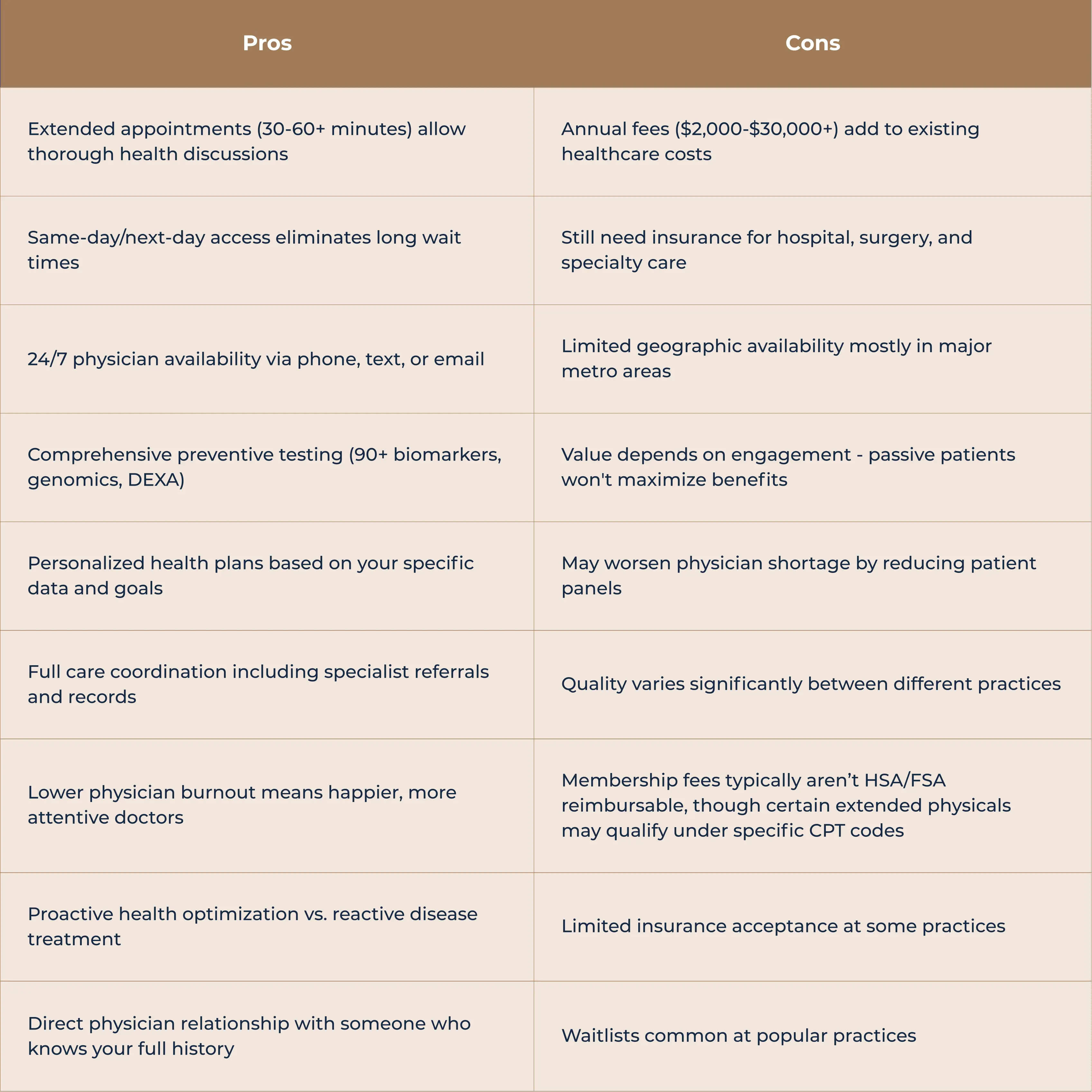

Traditional healthcare often feels rushed and impersonal. You wait weeks for an appointment, then get only a few minutes with your doctor.
That’s why more people are exploring concierge medicine. It promises time, access, and proactive care that puts your health first.
Before you decide, it’s worth understanding the real concierge medicine pros and cons so you can see whether this model truly fits your goals and lifestyle.
Let’s jump right in.

The promise sounds good on paper. You get more time with your doctor, better access, and proactive care instead of reactive treatment.
But do these benefits hold up in practice? Here's what the data shows.
Traditional primary care physicians manage around 2,000 to 2,500 patients and often see 20 to 25 people a day. Appointments typically last 15 to 20 minutes, limited by heavy patient loads and administrative demands.
Concierge medicine takes a different approach. Most concierge doctors care for smaller panels of about 400 to 600 members, allowing for deeper, more personalized attention. They usually see around 4 to 6 patients each day and spend additional time supporting members through email, text, and phone consultations.
At PrimaryMD, care is even more focused. Each physician oversees fewer than 250 members, or about 100 families, making it possible to understand every individual’s history, goals, and lifestyle in depth.
This structure allows for longer, more meaningful visits (often 30 minutes to an hour or more) and ensures your doctor has the time to think strategically about your health.
The average wait for a primary care appointment in major US cities now exceeds 26 days. Read that again. Nearly a month to see your doctor when something feels off.
Concierge practices guarantee same-day or next-day appointments. This immediate access prevents minor issues from becoming major problems.
That persistent cough gets evaluated before it becomes pneumonia. That unusual fatigue gets investigated before it derails your quarter.
Concierge medicine ensures that you’re never without support. You have round-the-clock coverage. Sometimes directly from your physician, and other times from an on-call clinician who has full access to your records. Many practices also partner with dedicated care teams or urgent care networks, such as Sollis, to handle after-hours needs seamlessly.
This level of access helps you avoid unnecessary ER visits and the high co-pays or deductible hits that often come with them. Most concerns can be handled in minutes over a call or message, saving you both time and money while ensuring your care stays connected and coordinated.
At PrimaryMD, every interaction is managed through your care team, so even when your physician isn’t available, you’re still speaking with someone who knows your history and can act on your plan immediately.
Traditional medicine waits until you're sick, then treats the disease. It's reactive, not proactive. You might get a basic blood panel once a year if you remember to schedule it, then hear "everything looks fine" even when you feel anything but fine.
Concierge medicine flips this model. Instead of waiting for problems, it hunts for them early when they're easiest to address.
For example, at PrimaryMD, members receive:
Navigating specialist referrals in traditional healthcare can feel like a part-time job. You wait weeks for appointments, records go missing, and you end up relaying information between providers who barely have time to review your case.
In a concierge model, a dedicated care team takes that burden off your plate. The physician provides medical direction while a patient-care coordinator manages logistics, referrals, and communication among specialists. Every provider involved in your care stays informed, and follow-ups happen without you having to chase them.
The result is simple: clear communication, coordinated care, and one team that understands your full history and keeps every part of your health connected.
This might seem like it's about them, not you. But physician wellbeing directly impacts your care quality.
Research shows 63% of primary care physicians experience burnout in traditional settings. Burned-out doctors make more errors, spend less time with patients, and are more likely to miss subtle diagnostic clues.
Concierge doctors report higher job satisfaction due to smaller patient panels and meaningful relationships. This translates to sharper clinical thinking, better pattern recognition, and physicians who actually remember your concerns from visit to visit.
Ready to experience healthcare built on genuine time and connection? Join the PrimaryMD waitlist to see how our physician-led approach redefines personalized care.
Nothing's perfect, and concierge medicine has real limitations. Understanding these drawbacks helps you decide if the model fits your situation and expectations.
Concierge medicine requires annual fees ranging from $2,000 to $30,000, depending on the practice and services included. This is an out-of-pocket expense not covered by insurance.
But context matters. Americans spend an average of $14,000 annually on healthcare when you factor in premiums, deductibles, copays, and out-of-pocket costs. The question isn't whether concierge medicine costs money. It's whether that money delivers better outcomes than the fragmented, reactive care you're getting now.
For professionals who value their time and health optimization, the investment makes sense. For those primarily seeking basic acute care, it might not.
Concierge membership doesn't replace insurance. You'll still need coverage for hospitalizations, surgeries, specialty medications, emergency care, and most diagnostic imaging.
Think of concierge medicine as premium access and preventive care, not comprehensive coverage.
Many practices, including PrimaryMD, work with insurance for covered services. The membership fee covers enhanced access, extended time, and services that insurance doesn't reimburse, like those two-hour consultations and quarterly optimization reviews.
Quality concierge practices concentrate in major metropolitan areas. Rural and suburban regions lack options entirely.
While telemedicine expands access for follow-ups, initial comprehensive assessments, and certain diagnostics require in-person visits.
For example, PrimaryMD currently serves San Francisco, New York City, and Boston, with expansion plans based on member demand. If you're outside these areas, you'll need to factor in travel for your initial assessment and periodic in-person visits.
The value of concierge medicine depends on engagement. Members who only seek care for acute issues won't maximize their investment.
Engaged members (those completing recommended testing and following personalized protocols) experience fewer hospitalizations than traditional care patients. But passive members may find the cost unjustifiable.
Critics argue that concierge medicine worsens physician shortages by reducing patient panels. The Association of American Medical Colleges projects an 86,000 physician shortage by 2036.
However, concierge medicine may retain physicians who would otherwise leave due to burnout. Additionally, the preventive focus reduces the burden of specialists and emergency departments, improving overall system efficiency.
Not all concierge practices offer the same services. Some provide only extended appointments and 24/7 access, while others include comprehensive testing, health coaching, and care coordination.
Research your options carefully. Ask about:
The decision ultimately comes down to how you value your time, health, and future. Most people spend more time researching their next car purchase than investigating the healthcare model that will shape their longevity and quality of life.
Consider this: what's the cost of delayed diagnoses, unnecessary ER visits, and the gradual health decline that comes from neglecting prevention? What's the value of a physician who knows your history, responds to your messages, and thinks strategically about your long-term health?
For ambitious professionals ready to approach their health with the same intentionality they bring to their careers, concierge medicine provides the infrastructure for sustained peak performance. For those content with reactive care and occasional checkups, traditional medicine might suffice.
The model isn't for everyone. But for those who recognize health as their most valuable asset, the investment often proves to be the best financial decision they make.
Ready to experience healthcare that aligns with your goals, schedule, and standards? Join our waitlist to secure early access to personalized, physician-led care that keeps you performing at your best.